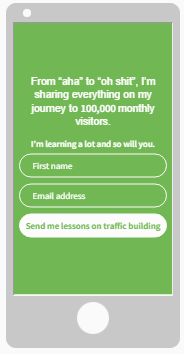Two years ago, Google introduced the mobile-friendly label. Then we witnessed ‘mobilegeddon’, where Google began prioritizing these mobile sites. Now, they are cracking down on mobile sites offering a substandard user experience.
On January 10th 2017, any sites with intrusive interstitials may lose ranking juice. The key question then is, what counts as an intrusive interstitial? Essentially, it’s any extraneous content that appears over the majority of the page proper. Call them silly, but Google assumes visitors enjoy seeing the information they clicked for.
At this point you may well have further questions; fortunately, I am here to answer them. In this post, I will help you decide exactly what will and won’t count as an intrusive interstitial by Google. Let’s get straight to it!
What Is an Intrusive Interstitial?
Intrusive interstitials are essentially popup ads. They tend to block most or all of a page, leading to a bad user experience for desktop and mobile users alike.
 Google’s own examples of intrusive interstitials.
Google’s own examples of intrusive interstitials.These types of ads make it frustrating at best to access the page as intended. The general exception to the rule is when there are legally required (or ethically advised) notifications, such as popups for age verification.
The kicker is that while popups are moderately annoying on desktops, there is even less screen real estate to work with on mobile devices. In these cases, it can completely ruin the user experience. Here are a few examples of how this goes wrong:
- The interstitial covers most or all of the content on a page.
- The interstitial is not responsive. That means it is difficult or impossible to close it on a mobile, rendering the page useless for mobile users.
- The interstitial is not triggered by an action, such as “Click here to subscribe.” Rather, it pops up on its own without prompting, creating an unpleasant surprise for the mobile viewer.
As you can see, the issue is not only the annoyance of popups but their role in ruining the user experience. If you find an interstitial on your own site that you’re not sure of, we find it best to err on the side of a pleasing experience for the user.
Why Are Intrusive Interstitials Being Targeted?
Our first clue that Google was shifting from banning app interstitials to all interstitials was August 2015, when Gary Illyes confessed to the world that he’d love to use them as a negative ranking factor one day. Back then, he said, “But we don’t have anything to announce at the moment.”
By now, you already have a bit of insight into Google’s decision. For a better understanding of what exactly is under scrutiny as January 10th races towards us, we can look at the factors that play a role in the market.
As frustrating as users find popups, companies continue to use them because they are effective. In one recent study of 1,754,957,675 popups, there was an average 3.09% conversion rate, with high-performing popups performing on average at 9.28%.
However, mobile traffic is growing, and Google seems to be leaning into it hard. In 2015, Google reported that access via mobile was higher than desktop searches in ten countries. Meanwhile, it’s worth noting that 56% of traffic on major sites comes from mobile.
HubSpot’s Senior Product Marketing Manager, Marcus Andrews, recently gave us a friendly reminder that “Google is very focused on the user.” He notes, “Marketers are always looking for hacky ways to increase traffic and conversion rates, and every once in a while, Google needs to make a correction to improve the user experience.”
It’s no surprise then that Google is focusing its resources on mobile, rather than desktop. It’s where the majority of users are — that’s just good business. Between this and its Accelerated Mobile Pages (AMP) project, it’s fair to say Google wants webmasters to offer a seamless user experience for mobile users.
It’s important to note that Google is currently only looking at interstitials that show up when the user first lands on the website from a search result. This means the important part is ensuring that any traffic coming from Google isn’t served these interstitials until the user has clicked further into the site.
“What we’re looking for is really interstitials that show up on the interaction between the search click and going through the page and seeing the content. What you do afterward like if someone clicks on stuff within your website or closes the tab or something like that then that’s kind of between you and the user,” John Mueller from Google Webmaster Central announced during an office-hours Google+ hangout.
How to Identify Intrusive Interstitials
Google has already decided that all interstitials ruining the user experience will negatively impact that site’s ranking signal.
What you need now is a blueprint to check your own site against. How can you tell which interstitials are okay, and which aren’t? Keep reading!
Intrusive Interstitials That Will Be Penalized
The examples of penalized interstitials provided by Google are relatively straightforward. So far, we know of three types of interstitials that will be problematic.
The first is a regular popup, or a modal window blocking the content of the page. These often come with a dark semi-transparent background dimming the rest of the content. These are perhaps the most traditional popups, in that they appear to literally pop up over the rest of the page.
 An example of an intrusive popup from Google: a regular popup, or a modal window blocking the content of the page.
An example of an intrusive popup from Google: a regular popup, or a modal window blocking the content of the page.You can see how the background dims to a dark gray for the modal popup:
 A real-life example of a regular intrusive popup.
A real-life example of a regular intrusive popup.The second is a standalone, full-screen interstitial that sits above the header of the website. These interstitials typically force your browser to scroll up to see it before letting you see the rest of the content.
 An example of an intrusive standalone interstitial from Google: a standalone, full-screen interstitial that sits above the header of the website.
An example of an intrusive standalone interstitial from Google: a standalone, full-screen interstitial that sits above the header of the website.The last is also a standalone, but essentially a full-screen modal window blocking the content.
 Another example of an intrusive standalone interstitial from Google: essentially a full-screen modal window blocking the content.
Another example of an intrusive standalone interstitial from Google: essentially a full-screen modal window blocking the content.Its functionality is like that of a regular popup, but you get no preview of what content lies below. In practice, they look exactly the same as the previous standalone popup. Here’s a real-life example:
 A real-life example of an intrusive standalone interstitial that blocks the content.
A real-life example of an intrusive standalone interstitial that blocks the content.However, in some cases, it doesn’t seem so cut and dry. For example, what if you have a live chat box that automatically appears to help the guest? This isn’t a direct advertisement, but it does still ruin the user experience if all they want to do is read the content they came for.
In these cases, think about the popup in its purest form — a box that appears over the actual page content. If it’s not a necessity, there’s a good chance it’s going to be penalized.
Intrusive Interstitials That Shouldn’t Be Penalized
It’s important to remember that not all interstitials will be an issue. Depending on your website and country, you may have legal or ethical reasons to display interstitials. Google knows this, and isn’t planning to punish you for it.
Google provides two predominant examples of these legally required interstitials, the first being legally required age verification blockers. These help create a shield for age-sensitive content such as websites featuring alcohol or adult content. The second example is cookie consent notifications, as they are required in the EU.
Finally, and perhaps most importantly, any banners taking up a “reasonable amount of space” should be safe. Though an exact size is not provided, it is better to play it safe and assume less is more. If you keep it to 15% or less, even landscape mode devices will still have enough room to read several lines of text.
This goes to show that you can still keep your ads, but you may need to switch up your approach by respecting the user’s screen space first and foremost. Try redesigning interstitials you can’t part with so they take up a small amount of the page, perhaps reducing them to a link that leads to a separate page entirely. In a last-ditch effort, you could change them to be inline ads. If you’re not sure what works best, try A/B testing to find an effective middle ground.
All this said, there is no guarantee of what will or will not be counted against you. Google only notes that these, when used responsibly, will not be affected.
Conclusion
As the deadline draws near, we urge you to check your interstitials and ensure they follow Google’s new guidelines. Though it’s not clear how strong this new ranking signal will be, Google shows a definitive preference for mobile. We recommend that you don’t underestimate its power.
It is relatively straightforward to identify your intrusive interstitials and take action:
- Review required interstitials, such as age-verification popups and cookie notifications. You’ll leave these live, but ensure they are easy to use on mobile devices.
- Find the interstitials on your site, leading directly from Google search, that act as advertisements.
- If these are so effective that you can’t justify getting rid of them, try modifying them to take up a small amount of screen space for mobile devices. Otherwise, we recommend removing them entirely.
What are your fears about the new intrusive interstitial ranking signal? Ask any further questions you have in the comments section below!
Image credits:
Featured image: georgejmclittle/DepositPhotos.com
Screenshots by Aleh Barysevich. Taken November 2016.





